Environmental Impact Assessment: Western Australia EIA Case Study
VerifiedAdded on 2023/06/10
|15
|3762
|125
Report
AI Summary
This report provides an analysis of Environmental Impact Assessment (EIA) practices, focusing on the best practices of EIA and its comparisons with theories and practices. It uses the Yanchep Rail Extension project in Western Australia as a case study, highlighting the role of public participation in the EIA process. The report reviews international EIA literature, establishes criteria for public participation, and assesses the conformance of the Western Australian case study to these criteria. It discusses the importance of public consultation, the objectives of public participation, and the challenges in implementing effective public involvement in EIA, especially in developing countries. The report concludes that public consultation and participation are vital parts of the EIA and environmental protection policies in Western Australia.
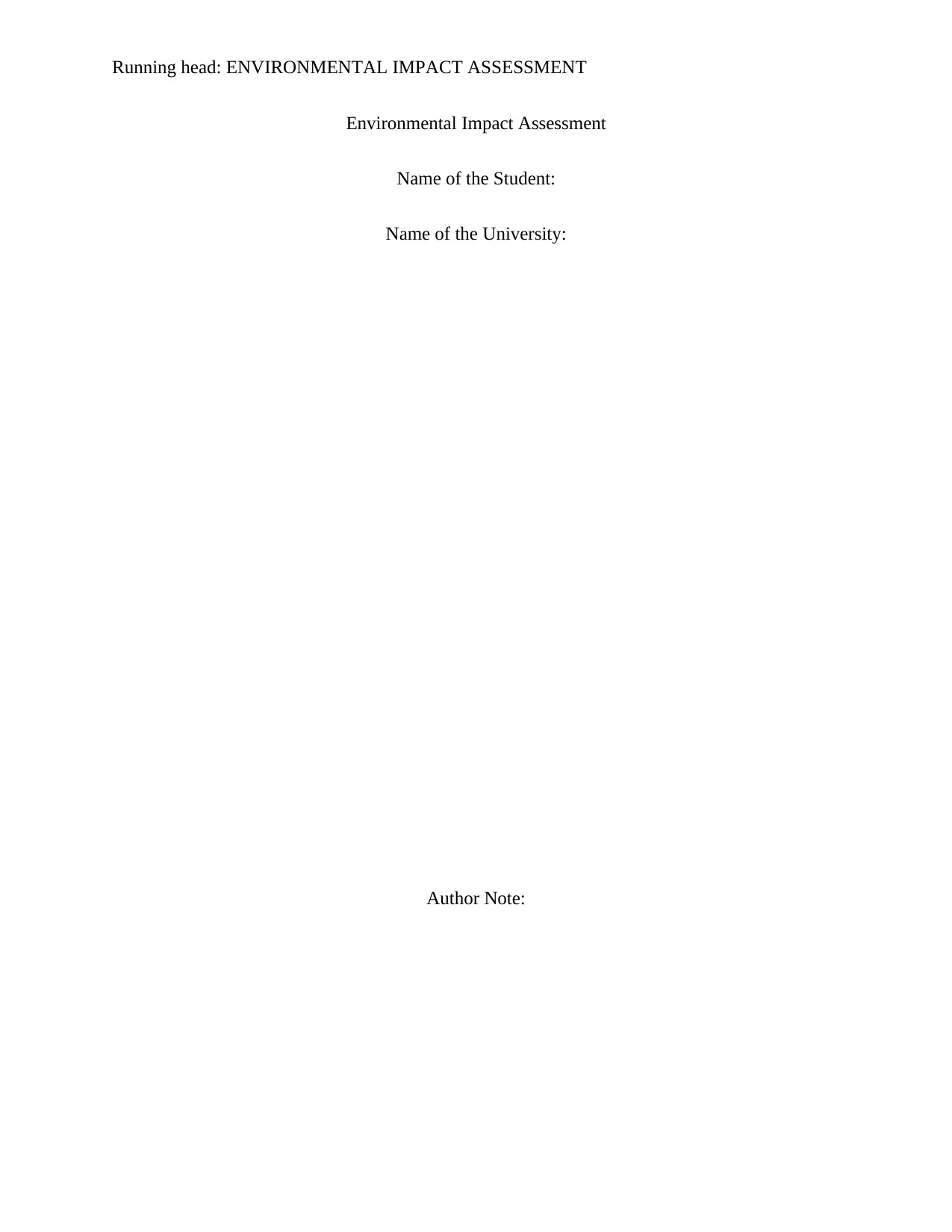
Running head: ENVIRONMENTAL IMPACT ASSESSMENT
Environmental Impact Assessment
Name of the Student:
Name of the University:
Author Note:
Environmental Impact Assessment
Name of the Student:
Name of the University:
Author Note:
Paraphrase This Document
Need a fresh take? Get an instant paraphrase of this document with our AI Paraphraser
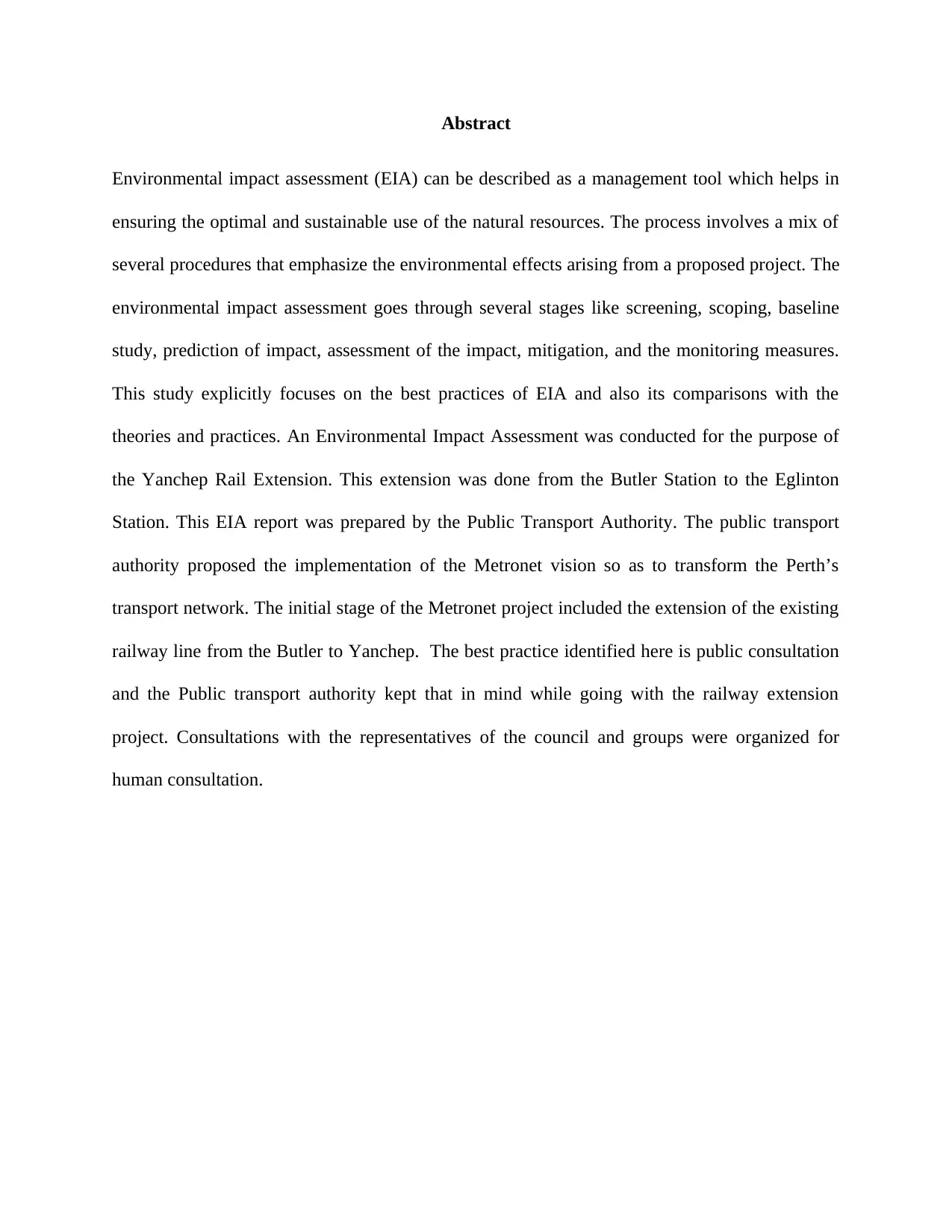
Abstract
Environmental impact assessment (EIA) can be described as a management tool which helps in
ensuring the optimal and sustainable use of the natural resources. The process involves a mix of
several procedures that emphasize the environmental effects arising from a proposed project. The
environmental impact assessment goes through several stages like screening, scoping, baseline
study, prediction of impact, assessment of the impact, mitigation, and the monitoring measures.
This study explicitly focuses on the best practices of EIA and also its comparisons with the
theories and practices. An Environmental Impact Assessment was conducted for the purpose of
the Yanchep Rail Extension. This extension was done from the Butler Station to the Eglinton
Station. This EIA report was prepared by the Public Transport Authority. The public transport
authority proposed the implementation of the Metronet vision so as to transform the Perth’s
transport network. The initial stage of the Metronet project included the extension of the existing
railway line from the Butler to Yanchep. The best practice identified here is public consultation
and the Public transport authority kept that in mind while going with the railway extension
project. Consultations with the representatives of the council and groups were organized for
human consultation.
Environmental impact assessment (EIA) can be described as a management tool which helps in
ensuring the optimal and sustainable use of the natural resources. The process involves a mix of
several procedures that emphasize the environmental effects arising from a proposed project. The
environmental impact assessment goes through several stages like screening, scoping, baseline
study, prediction of impact, assessment of the impact, mitigation, and the monitoring measures.
This study explicitly focuses on the best practices of EIA and also its comparisons with the
theories and practices. An Environmental Impact Assessment was conducted for the purpose of
the Yanchep Rail Extension. This extension was done from the Butler Station to the Eglinton
Station. This EIA report was prepared by the Public Transport Authority. The public transport
authority proposed the implementation of the Metronet vision so as to transform the Perth’s
transport network. The initial stage of the Metronet project included the extension of the existing
railway line from the Butler to Yanchep. The best practice identified here is public consultation
and the Public transport authority kept that in mind while going with the railway extension
project. Consultations with the representatives of the council and groups were organized for
human consultation.
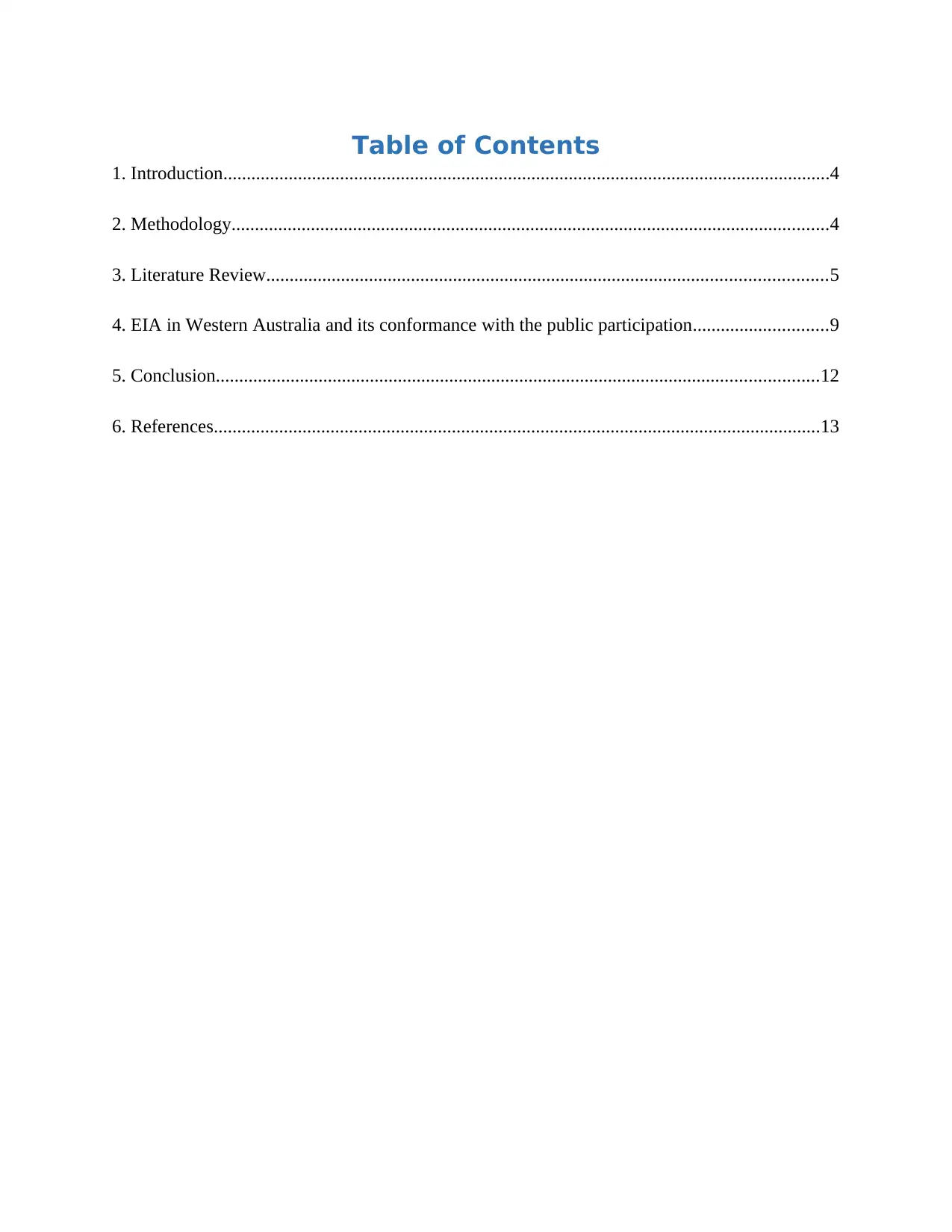
Table of Contents
1. Introduction..................................................................................................................................4
2. Methodology................................................................................................................................4
3. Literature Review........................................................................................................................5
4. EIA in Western Australia and its conformance with the public participation.............................9
5. Conclusion.................................................................................................................................12
6. References..................................................................................................................................13
1. Introduction..................................................................................................................................4
2. Methodology................................................................................................................................4
3. Literature Review........................................................................................................................5
4. EIA in Western Australia and its conformance with the public participation.............................9
5. Conclusion.................................................................................................................................12
6. References..................................................................................................................................13
⊘ This is a preview!⊘
Do you want full access?
Subscribe today to unlock all pages.

Trusted by 1+ million students worldwide
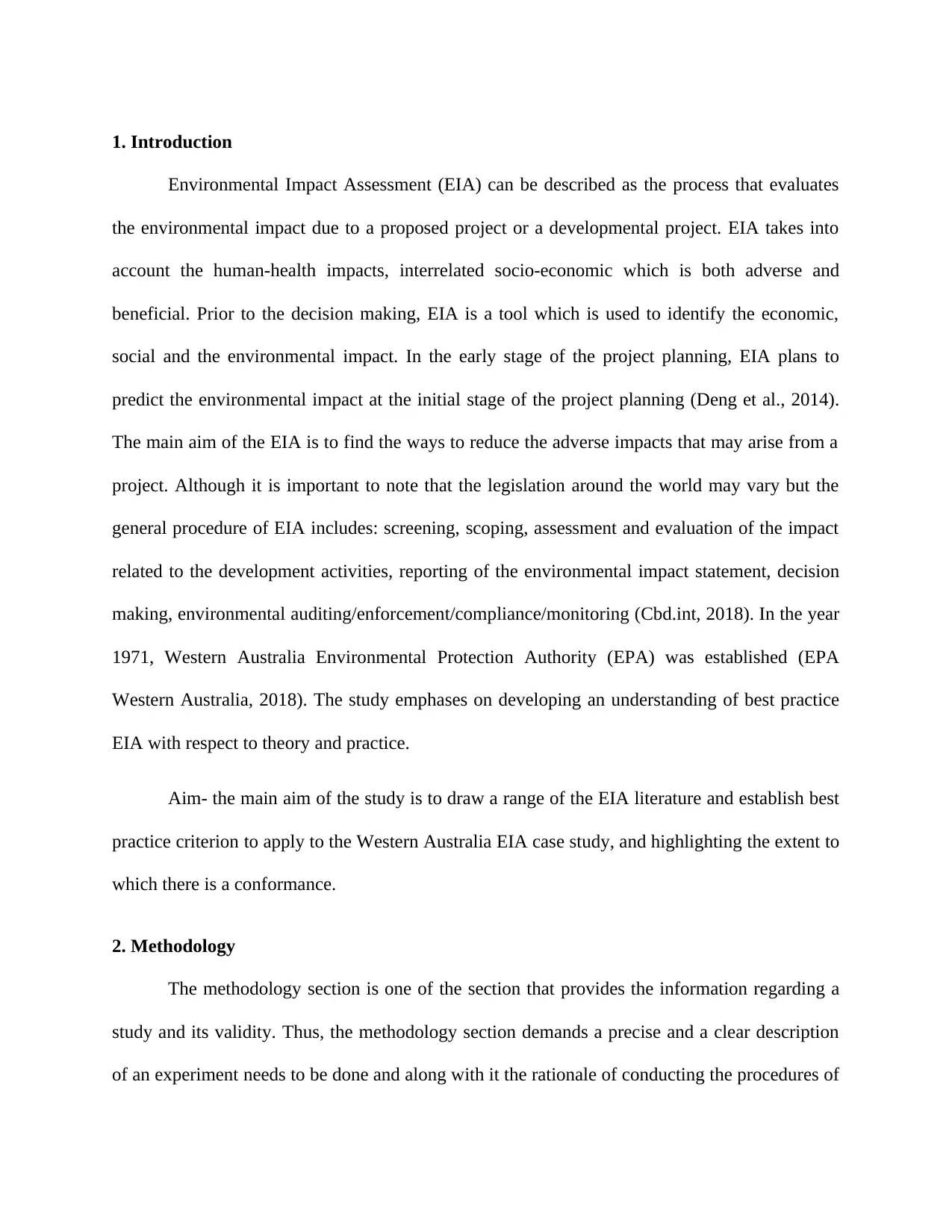
1. Introduction
Environmental Impact Assessment (EIA) can be described as the process that evaluates
the environmental impact due to a proposed project or a developmental project. EIA takes into
account the human-health impacts, interrelated socio-economic which is both adverse and
beneficial. Prior to the decision making, EIA is a tool which is used to identify the economic,
social and the environmental impact. In the early stage of the project planning, EIA plans to
predict the environmental impact at the initial stage of the project planning (Deng et al., 2014).
The main aim of the EIA is to find the ways to reduce the adverse impacts that may arise from a
project. Although it is important to note that the legislation around the world may vary but the
general procedure of EIA includes: screening, scoping, assessment and evaluation of the impact
related to the development activities, reporting of the environmental impact statement, decision
making, environmental auditing/enforcement/compliance/monitoring (Cbd.int, 2018). In the year
1971, Western Australia Environmental Protection Authority (EPA) was established (EPA
Western Australia, 2018). The study emphases on developing an understanding of best practice
EIA with respect to theory and practice.
Aim- the main aim of the study is to draw a range of the EIA literature and establish best
practice criterion to apply to the Western Australia EIA case study, and highlighting the extent to
which there is a conformance.
2. Methodology
The methodology section is one of the section that provides the information regarding a
study and its validity. Thus, the methodology section demands a precise and a clear description
of an experiment needs to be done and along with it the rationale of conducting the procedures of
Environmental Impact Assessment (EIA) can be described as the process that evaluates
the environmental impact due to a proposed project or a developmental project. EIA takes into
account the human-health impacts, interrelated socio-economic which is both adverse and
beneficial. Prior to the decision making, EIA is a tool which is used to identify the economic,
social and the environmental impact. In the early stage of the project planning, EIA plans to
predict the environmental impact at the initial stage of the project planning (Deng et al., 2014).
The main aim of the EIA is to find the ways to reduce the adverse impacts that may arise from a
project. Although it is important to note that the legislation around the world may vary but the
general procedure of EIA includes: screening, scoping, assessment and evaluation of the impact
related to the development activities, reporting of the environmental impact statement, decision
making, environmental auditing/enforcement/compliance/monitoring (Cbd.int, 2018). In the year
1971, Western Australia Environmental Protection Authority (EPA) was established (EPA
Western Australia, 2018). The study emphases on developing an understanding of best practice
EIA with respect to theory and practice.
Aim- the main aim of the study is to draw a range of the EIA literature and establish best
practice criterion to apply to the Western Australia EIA case study, and highlighting the extent to
which there is a conformance.
2. Methodology
The methodology section is one of the section that provides the information regarding a
study and its validity. Thus, the methodology section demands a precise and a clear description
of an experiment needs to be done and along with it the rationale of conducting the procedures of
Paraphrase This Document
Need a fresh take? Get an instant paraphrase of this document with our AI Paraphraser
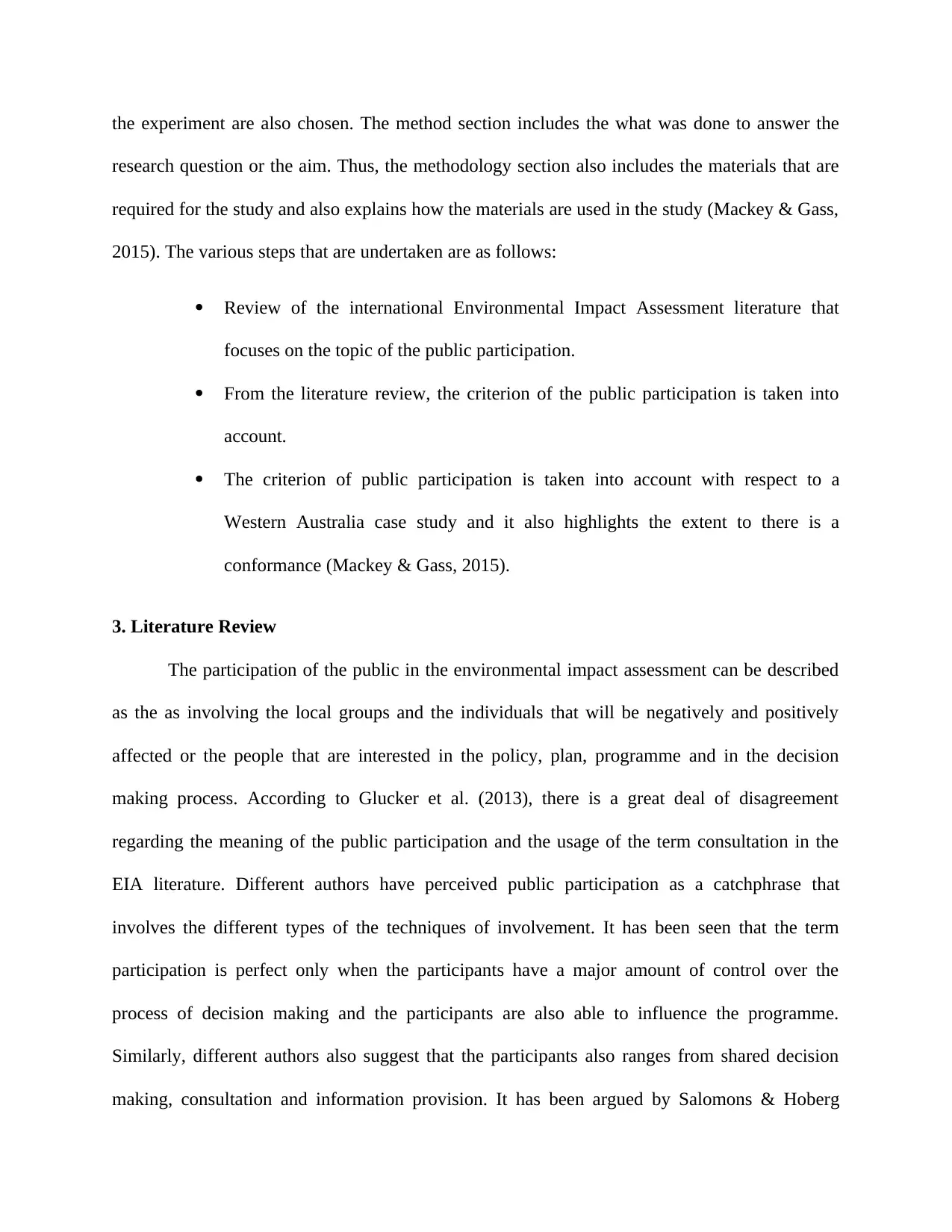
the experiment are also chosen. The method section includes the what was done to answer the
research question or the aim. Thus, the methodology section also includes the materials that are
required for the study and also explains how the materials are used in the study (Mackey & Gass,
2015). The various steps that are undertaken are as follows:
Review of the international Environmental Impact Assessment literature that
focuses on the topic of the public participation.
From the literature review, the criterion of the public participation is taken into
account.
The criterion of public participation is taken into account with respect to a
Western Australia case study and it also highlights the extent to there is a
conformance (Mackey & Gass, 2015).
3. Literature Review
The participation of the public in the environmental impact assessment can be described
as the as involving the local groups and the individuals that will be negatively and positively
affected or the people that are interested in the policy, plan, programme and in the decision
making process. According to Glucker et al. (2013), there is a great deal of disagreement
regarding the meaning of the public participation and the usage of the term consultation in the
EIA literature. Different authors have perceived public participation as a catchphrase that
involves the different types of the techniques of involvement. It has been seen that the term
participation is perfect only when the participants have a major amount of control over the
process of decision making and the participants are also able to influence the programme.
Similarly, different authors also suggest that the participants also ranges from shared decision
making, consultation and information provision. It has been argued by Salomons & Hoberg
research question or the aim. Thus, the methodology section also includes the materials that are
required for the study and also explains how the materials are used in the study (Mackey & Gass,
2015). The various steps that are undertaken are as follows:
Review of the international Environmental Impact Assessment literature that
focuses on the topic of the public participation.
From the literature review, the criterion of the public participation is taken into
account.
The criterion of public participation is taken into account with respect to a
Western Australia case study and it also highlights the extent to there is a
conformance (Mackey & Gass, 2015).
3. Literature Review
The participation of the public in the environmental impact assessment can be described
as the as involving the local groups and the individuals that will be negatively and positively
affected or the people that are interested in the policy, plan, programme and in the decision
making process. According to Glucker et al. (2013), there is a great deal of disagreement
regarding the meaning of the public participation and the usage of the term consultation in the
EIA literature. Different authors have perceived public participation as a catchphrase that
involves the different types of the techniques of involvement. It has been seen that the term
participation is perfect only when the participants have a major amount of control over the
process of decision making and the participants are also able to influence the programme.
Similarly, different authors also suggest that the participants also ranges from shared decision
making, consultation and information provision. It has been argued by Salomons & Hoberg
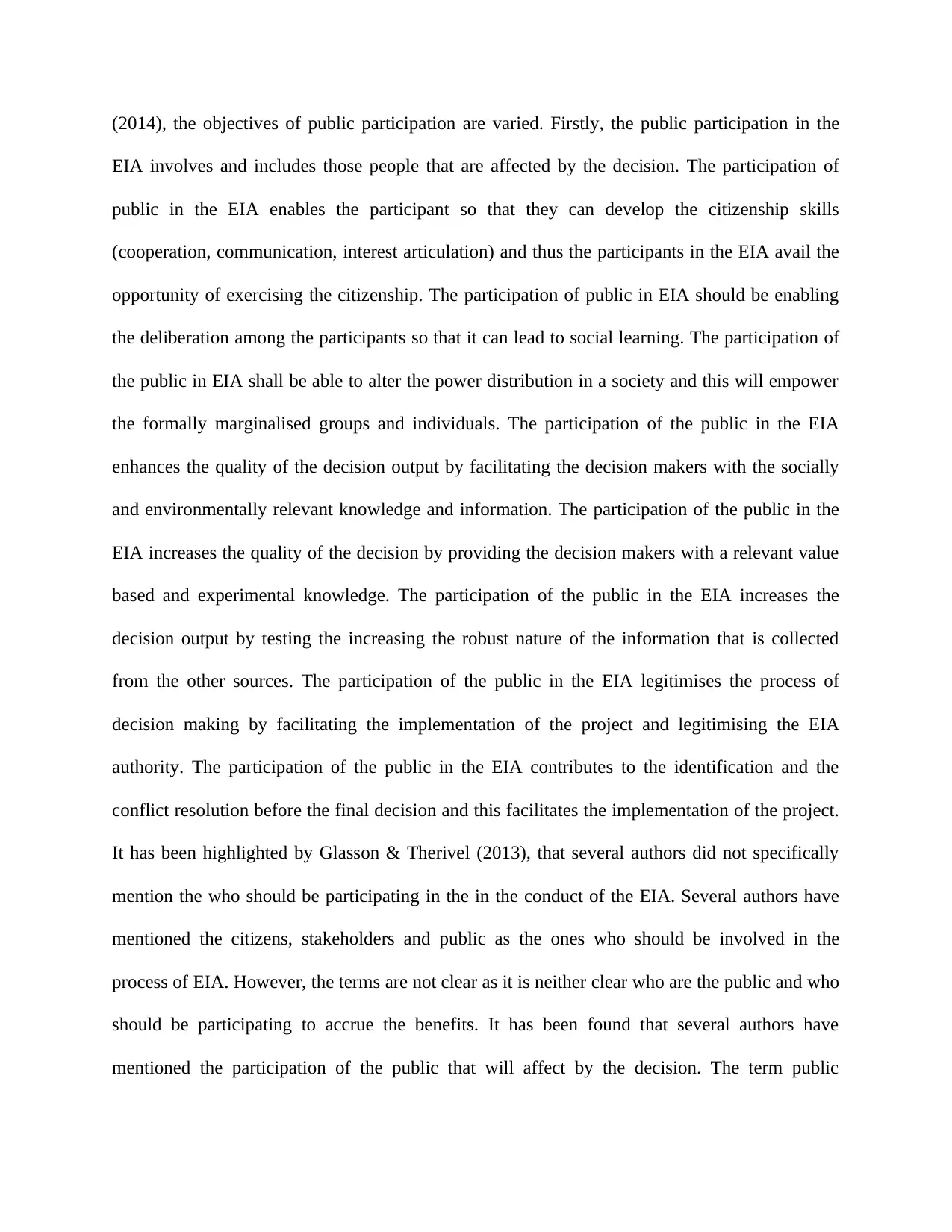
(2014), the objectives of public participation are varied. Firstly, the public participation in the
EIA involves and includes those people that are affected by the decision. The participation of
public in the EIA enables the participant so that they can develop the citizenship skills
(cooperation, communication, interest articulation) and thus the participants in the EIA avail the
opportunity of exercising the citizenship. The participation of public in EIA should be enabling
the deliberation among the participants so that it can lead to social learning. The participation of
the public in EIA shall be able to alter the power distribution in a society and this will empower
the formally marginalised groups and individuals. The participation of the public in the EIA
enhances the quality of the decision output by facilitating the decision makers with the socially
and environmentally relevant knowledge and information. The participation of the public in the
EIA increases the quality of the decision by providing the decision makers with a relevant value
based and experimental knowledge. The participation of the public in the EIA increases the
decision output by testing the increasing the robust nature of the information that is collected
from the other sources. The participation of the public in the EIA legitimises the process of
decision making by facilitating the implementation of the project and legitimising the EIA
authority. The participation of the public in the EIA contributes to the identification and the
conflict resolution before the final decision and this facilitates the implementation of the project.
It has been highlighted by Glasson & Therivel (2013), that several authors did not specifically
mention the who should be participating in the in the conduct of the EIA. Several authors have
mentioned the citizens, stakeholders and public as the ones who should be involved in the
process of EIA. However, the terms are not clear as it is neither clear who are the public and who
should be participating to accrue the benefits. It has been found that several authors have
mentioned the participation of the public that will affect by the decision. The term public
EIA involves and includes those people that are affected by the decision. The participation of
public in the EIA enables the participant so that they can develop the citizenship skills
(cooperation, communication, interest articulation) and thus the participants in the EIA avail the
opportunity of exercising the citizenship. The participation of public in EIA should be enabling
the deliberation among the participants so that it can lead to social learning. The participation of
the public in EIA shall be able to alter the power distribution in a society and this will empower
the formally marginalised groups and individuals. The participation of the public in the EIA
enhances the quality of the decision output by facilitating the decision makers with the socially
and environmentally relevant knowledge and information. The participation of the public in the
EIA increases the quality of the decision by providing the decision makers with a relevant value
based and experimental knowledge. The participation of the public in the EIA increases the
decision output by testing the increasing the robust nature of the information that is collected
from the other sources. The participation of the public in the EIA legitimises the process of
decision making by facilitating the implementation of the project and legitimising the EIA
authority. The participation of the public in the EIA contributes to the identification and the
conflict resolution before the final decision and this facilitates the implementation of the project.
It has been highlighted by Glasson & Therivel (2013), that several authors did not specifically
mention the who should be participating in the in the conduct of the EIA. Several authors have
mentioned the citizens, stakeholders and public as the ones who should be involved in the
process of EIA. However, the terms are not clear as it is neither clear who are the public and who
should be participating to accrue the benefits. It has been found that several authors have
mentioned the participation of the public that will affect by the decision. The term public
⊘ This is a preview!⊘
Do you want full access?
Subscribe today to unlock all pages.

Trusted by 1+ million students worldwide
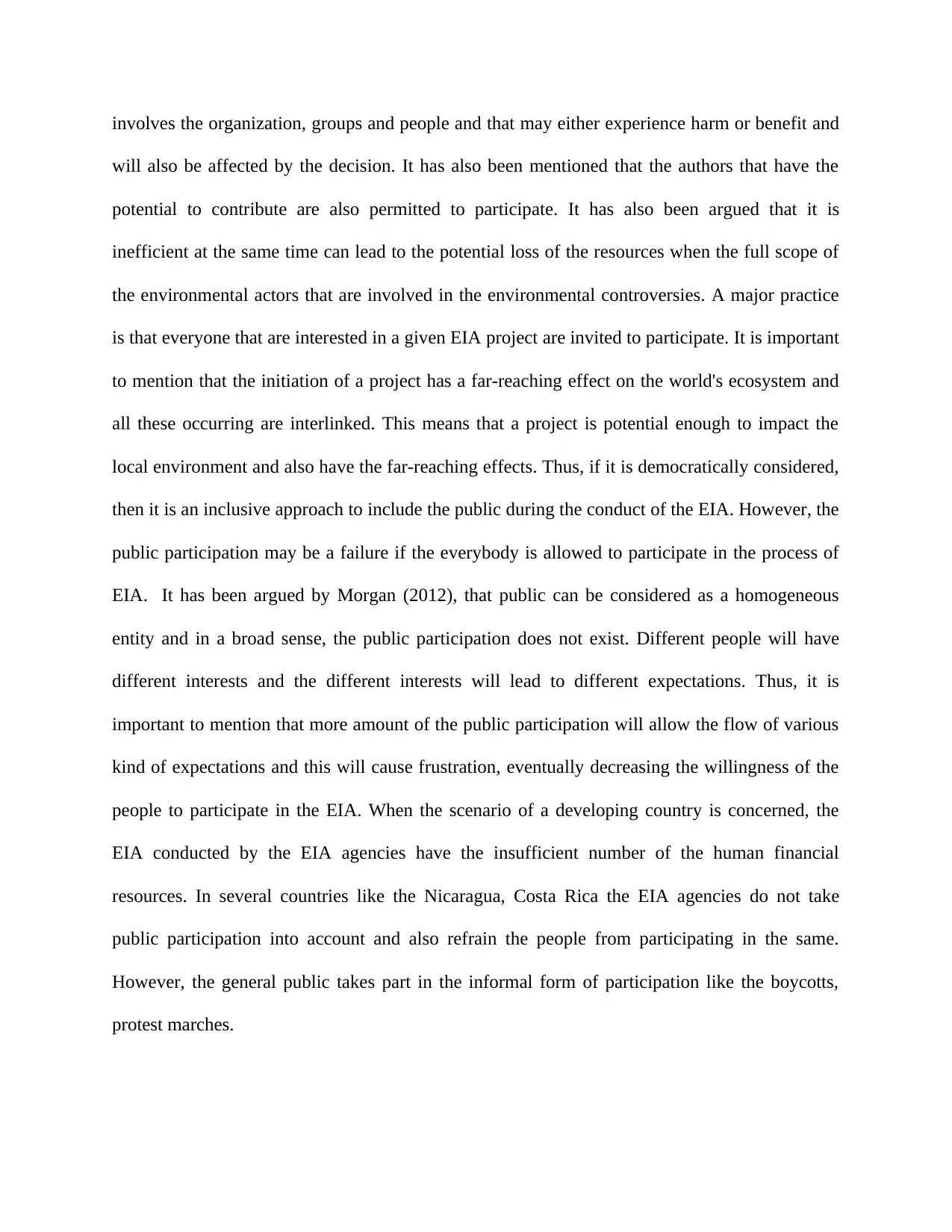
involves the organization, groups and people and that may either experience harm or benefit and
will also be affected by the decision. It has also been mentioned that the authors that have the
potential to contribute are also permitted to participate. It has also been argued that it is
inefficient at the same time can lead to the potential loss of the resources when the full scope of
the environmental actors that are involved in the environmental controversies. A major practice
is that everyone that are interested in a given EIA project are invited to participate. It is important
to mention that the initiation of a project has a far-reaching effect on the world's ecosystem and
all these occurring are interlinked. This means that a project is potential enough to impact the
local environment and also have the far-reaching effects. Thus, if it is democratically considered,
then it is an inclusive approach to include the public during the conduct of the EIA. However, the
public participation may be a failure if the everybody is allowed to participate in the process of
EIA. It has been argued by Morgan (2012), that public can be considered as a homogeneous
entity and in a broad sense, the public participation does not exist. Different people will have
different interests and the different interests will lead to different expectations. Thus, it is
important to mention that more amount of the public participation will allow the flow of various
kind of expectations and this will cause frustration, eventually decreasing the willingness of the
people to participate in the EIA. When the scenario of a developing country is concerned, the
EIA conducted by the EIA agencies have the insufficient number of the human financial
resources. In several countries like the Nicaragua, Costa Rica the EIA agencies do not take
public participation into account and also refrain the people from participating in the same.
However, the general public takes part in the informal form of participation like the boycotts,
protest marches.
will also be affected by the decision. It has also been mentioned that the authors that have the
potential to contribute are also permitted to participate. It has also been argued that it is
inefficient at the same time can lead to the potential loss of the resources when the full scope of
the environmental actors that are involved in the environmental controversies. A major practice
is that everyone that are interested in a given EIA project are invited to participate. It is important
to mention that the initiation of a project has a far-reaching effect on the world's ecosystem and
all these occurring are interlinked. This means that a project is potential enough to impact the
local environment and also have the far-reaching effects. Thus, if it is democratically considered,
then it is an inclusive approach to include the public during the conduct of the EIA. However, the
public participation may be a failure if the everybody is allowed to participate in the process of
EIA. It has been argued by Morgan (2012), that public can be considered as a homogeneous
entity and in a broad sense, the public participation does not exist. Different people will have
different interests and the different interests will lead to different expectations. Thus, it is
important to mention that more amount of the public participation will allow the flow of various
kind of expectations and this will cause frustration, eventually decreasing the willingness of the
people to participate in the EIA. When the scenario of a developing country is concerned, the
EIA conducted by the EIA agencies have the insufficient number of the human financial
resources. In several countries like the Nicaragua, Costa Rica the EIA agencies do not take
public participation into account and also refrain the people from participating in the same.
However, the general public takes part in the informal form of participation like the boycotts,
protest marches.
Paraphrase This Document
Need a fresh take? Get an instant paraphrase of this document with our AI Paraphraser
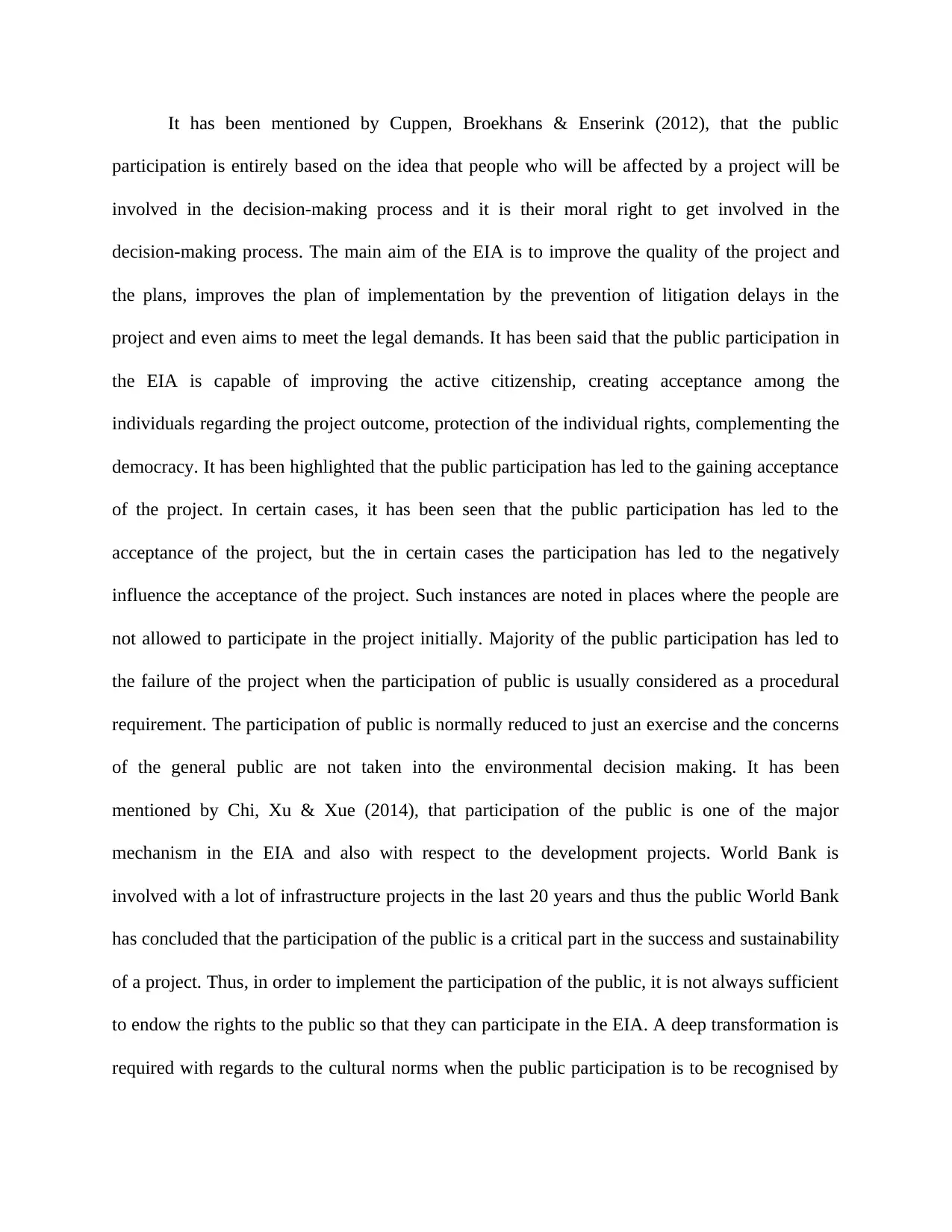
It has been mentioned by Cuppen, Broekhans & Enserink (2012), that the public
participation is entirely based on the idea that people who will be affected by a project will be
involved in the decision-making process and it is their moral right to get involved in the
decision-making process. The main aim of the EIA is to improve the quality of the project and
the plans, improves the plan of implementation by the prevention of litigation delays in the
project and even aims to meet the legal demands. It has been said that the public participation in
the EIA is capable of improving the active citizenship, creating acceptance among the
individuals regarding the project outcome, protection of the individual rights, complementing the
democracy. It has been highlighted that the public participation has led to the gaining acceptance
of the project. In certain cases, it has been seen that the public participation has led to the
acceptance of the project, but the in certain cases the participation has led to the negatively
influence the acceptance of the project. Such instances are noted in places where the people are
not allowed to participate in the project initially. Majority of the public participation has led to
the failure of the project when the participation of public is usually considered as a procedural
requirement. The participation of public is normally reduced to just an exercise and the concerns
of the general public are not taken into the environmental decision making. It has been
mentioned by Chi, Xu & Xue (2014), that participation of the public is one of the major
mechanism in the EIA and also with respect to the development projects. World Bank is
involved with a lot of infrastructure projects in the last 20 years and thus the public World Bank
has concluded that the participation of the public is a critical part in the success and sustainability
of a project. Thus, in order to implement the participation of the public, it is not always sufficient
to endow the rights to the public so that they can participate in the EIA. A deep transformation is
required with regards to the cultural norms when the public participation is to be recognised by
participation is entirely based on the idea that people who will be affected by a project will be
involved in the decision-making process and it is their moral right to get involved in the
decision-making process. The main aim of the EIA is to improve the quality of the project and
the plans, improves the plan of implementation by the prevention of litigation delays in the
project and even aims to meet the legal demands. It has been said that the public participation in
the EIA is capable of improving the active citizenship, creating acceptance among the
individuals regarding the project outcome, protection of the individual rights, complementing the
democracy. It has been highlighted that the public participation has led to the gaining acceptance
of the project. In certain cases, it has been seen that the public participation has led to the
acceptance of the project, but the in certain cases the participation has led to the negatively
influence the acceptance of the project. Such instances are noted in places where the people are
not allowed to participate in the project initially. Majority of the public participation has led to
the failure of the project when the participation of public is usually considered as a procedural
requirement. The participation of public is normally reduced to just an exercise and the concerns
of the general public are not taken into the environmental decision making. It has been
mentioned by Chi, Xu & Xue (2014), that participation of the public is one of the major
mechanism in the EIA and also with respect to the development projects. World Bank is
involved with a lot of infrastructure projects in the last 20 years and thus the public World Bank
has concluded that the participation of the public is a critical part in the success and sustainability
of a project. Thus, in order to implement the participation of the public, it is not always sufficient
to endow the rights to the public so that they can participate in the EIA. A deep transformation is
required with regards to the cultural norms when the public participation is to be recognised by
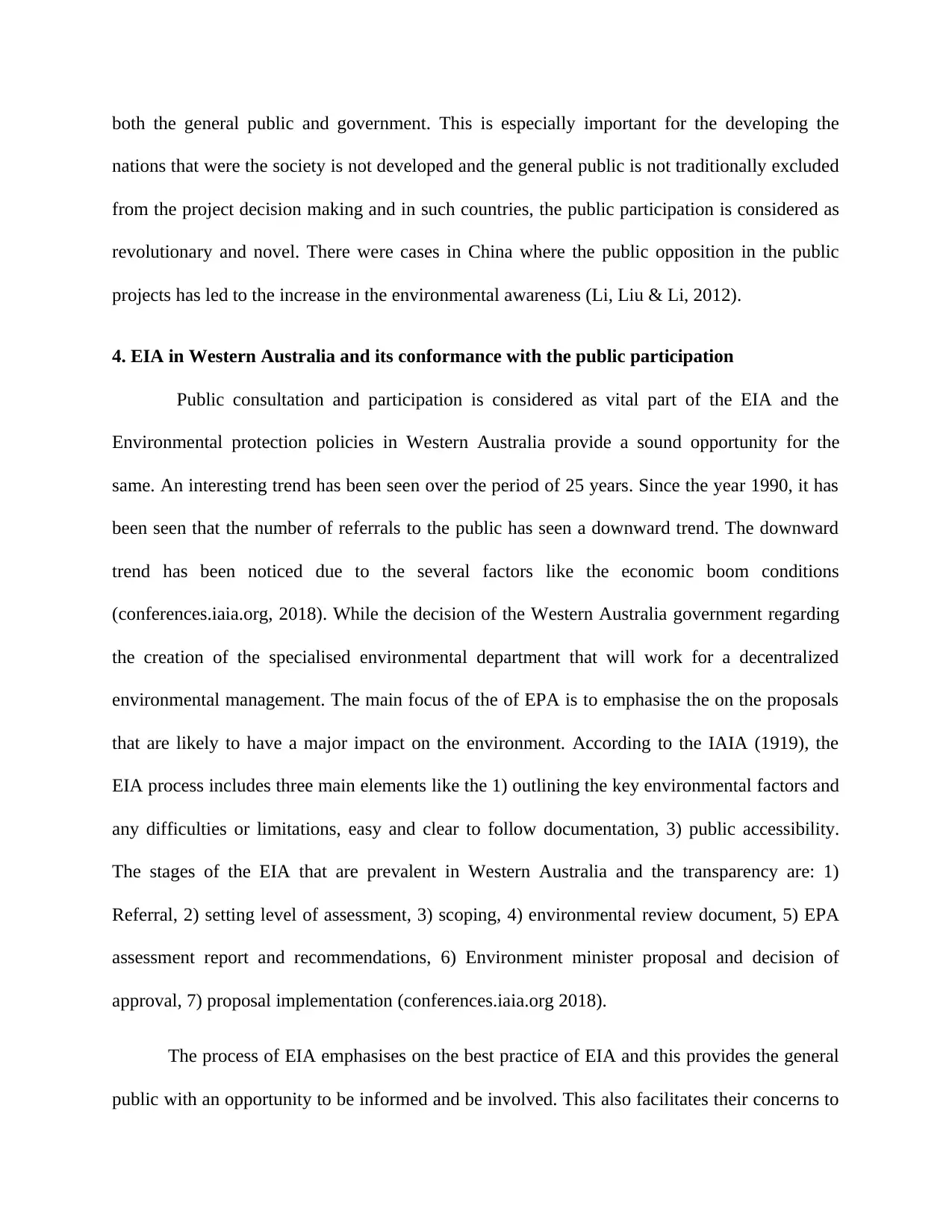
both the general public and government. This is especially important for the developing the
nations that were the society is not developed and the general public is not traditionally excluded
from the project decision making and in such countries, the public participation is considered as
revolutionary and novel. There were cases in China where the public opposition in the public
projects has led to the increase in the environmental awareness (Li, Liu & Li, 2012).
4. EIA in Western Australia and its conformance with the public participation
Public consultation and participation is considered as vital part of the EIA and the
Environmental protection policies in Western Australia provide a sound opportunity for the
same. An interesting trend has been seen over the period of 25 years. Since the year 1990, it has
been seen that the number of referrals to the public has seen a downward trend. The downward
trend has been noticed due to the several factors like the economic boom conditions
(conferences.iaia.org, 2018). While the decision of the Western Australia government regarding
the creation of the specialised environmental department that will work for a decentralized
environmental management. The main focus of the of EPA is to emphasise the on the proposals
that are likely to have a major impact on the environment. According to the IAIA (1919), the
EIA process includes three main elements like the 1) outlining the key environmental factors and
any difficulties or limitations, easy and clear to follow documentation, 3) public accessibility.
The stages of the EIA that are prevalent in Western Australia and the transparency are: 1)
Referral, 2) setting level of assessment, 3) scoping, 4) environmental review document, 5) EPA
assessment report and recommendations, 6) Environment minister proposal and decision of
approval, 7) proposal implementation (conferences.iaia.org 2018).
The process of EIA emphasises on the best practice of EIA and this provides the general
public with an opportunity to be informed and be involved. This also facilitates their concerns to
nations that were the society is not developed and the general public is not traditionally excluded
from the project decision making and in such countries, the public participation is considered as
revolutionary and novel. There were cases in China where the public opposition in the public
projects has led to the increase in the environmental awareness (Li, Liu & Li, 2012).
4. EIA in Western Australia and its conformance with the public participation
Public consultation and participation is considered as vital part of the EIA and the
Environmental protection policies in Western Australia provide a sound opportunity for the
same. An interesting trend has been seen over the period of 25 years. Since the year 1990, it has
been seen that the number of referrals to the public has seen a downward trend. The downward
trend has been noticed due to the several factors like the economic boom conditions
(conferences.iaia.org, 2018). While the decision of the Western Australia government regarding
the creation of the specialised environmental department that will work for a decentralized
environmental management. The main focus of the of EPA is to emphasise the on the proposals
that are likely to have a major impact on the environment. According to the IAIA (1919), the
EIA process includes three main elements like the 1) outlining the key environmental factors and
any difficulties or limitations, easy and clear to follow documentation, 3) public accessibility.
The stages of the EIA that are prevalent in Western Australia and the transparency are: 1)
Referral, 2) setting level of assessment, 3) scoping, 4) environmental review document, 5) EPA
assessment report and recommendations, 6) Environment minister proposal and decision of
approval, 7) proposal implementation (conferences.iaia.org 2018).
The process of EIA emphasises on the best practice of EIA and this provides the general
public with an opportunity to be informed and be involved. This also facilitates their concerns to
⊘ This is a preview!⊘
Do you want full access?
Subscribe today to unlock all pages.

Trusted by 1+ million students worldwide
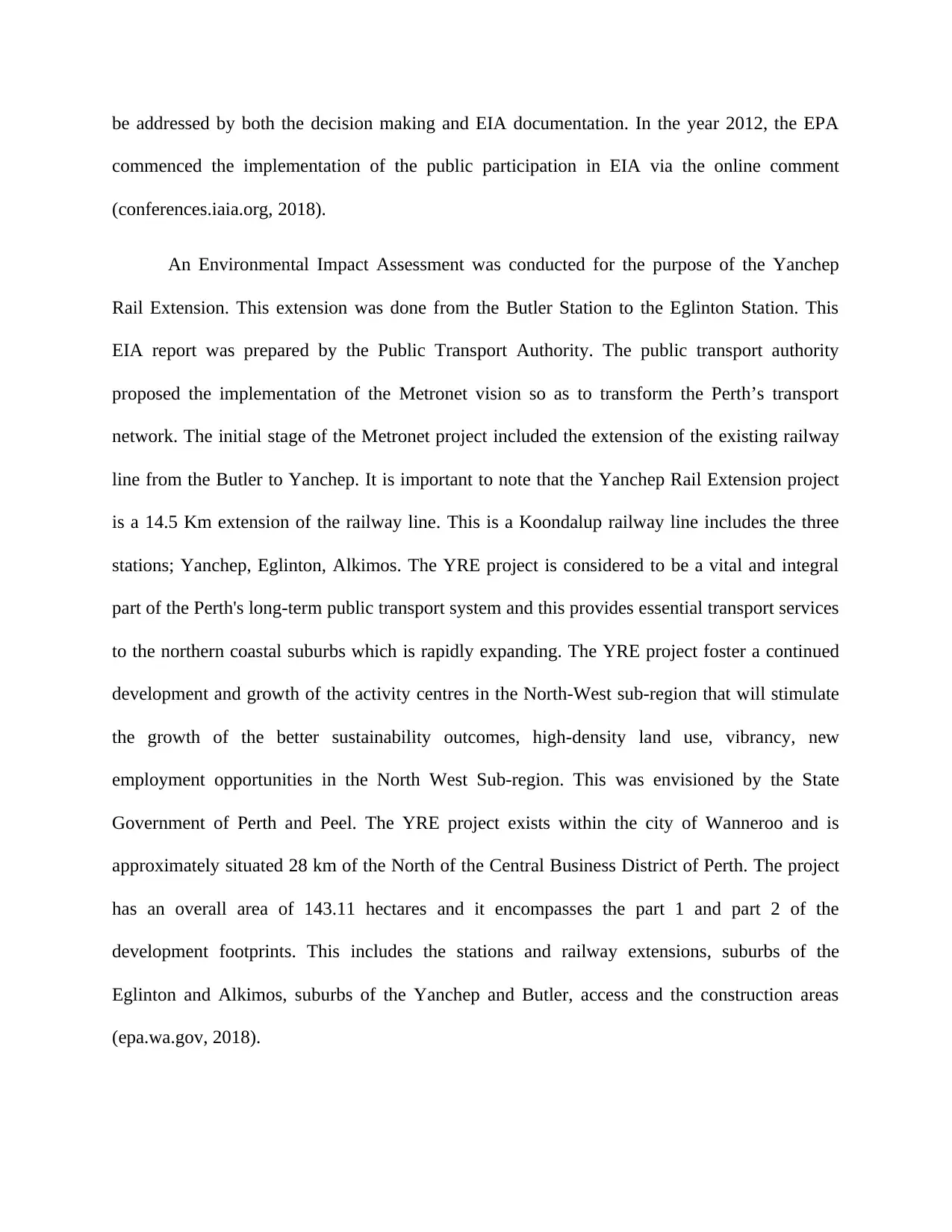
be addressed by both the decision making and EIA documentation. In the year 2012, the EPA
commenced the implementation of the public participation in EIA via the online comment
(conferences.iaia.org, 2018).
An Environmental Impact Assessment was conducted for the purpose of the Yanchep
Rail Extension. This extension was done from the Butler Station to the Eglinton Station. This
EIA report was prepared by the Public Transport Authority. The public transport authority
proposed the implementation of the Metronet vision so as to transform the Perth’s transport
network. The initial stage of the Metronet project included the extension of the existing railway
line from the Butler to Yanchep. It is important to note that the Yanchep Rail Extension project
is a 14.5 Km extension of the railway line. This is a Koondalup railway line includes the three
stations; Yanchep, Eglinton, Alkimos. The YRE project is considered to be a vital and integral
part of the Perth's long-term public transport system and this provides essential transport services
to the northern coastal suburbs which is rapidly expanding. The YRE project foster a continued
development and growth of the activity centres in the North-West sub-region that will stimulate
the growth of the better sustainability outcomes, high-density land use, vibrancy, new
employment opportunities in the North West Sub-region. This was envisioned by the State
Government of Perth and Peel. The YRE project exists within the city of Wanneroo and is
approximately situated 28 km of the North of the Central Business District of Perth. The project
has an overall area of 143.11 hectares and it encompasses the part 1 and part 2 of the
development footprints. This includes the stations and railway extensions, suburbs of the
Eglinton and Alkimos, suburbs of the Yanchep and Butler, access and the construction areas
(epa.wa.gov, 2018).
commenced the implementation of the public participation in EIA via the online comment
(conferences.iaia.org, 2018).
An Environmental Impact Assessment was conducted for the purpose of the Yanchep
Rail Extension. This extension was done from the Butler Station to the Eglinton Station. This
EIA report was prepared by the Public Transport Authority. The public transport authority
proposed the implementation of the Metronet vision so as to transform the Perth’s transport
network. The initial stage of the Metronet project included the extension of the existing railway
line from the Butler to Yanchep. It is important to note that the Yanchep Rail Extension project
is a 14.5 Km extension of the railway line. This is a Koondalup railway line includes the three
stations; Yanchep, Eglinton, Alkimos. The YRE project is considered to be a vital and integral
part of the Perth's long-term public transport system and this provides essential transport services
to the northern coastal suburbs which is rapidly expanding. The YRE project foster a continued
development and growth of the activity centres in the North-West sub-region that will stimulate
the growth of the better sustainability outcomes, high-density land use, vibrancy, new
employment opportunities in the North West Sub-region. This was envisioned by the State
Government of Perth and Peel. The YRE project exists within the city of Wanneroo and is
approximately situated 28 km of the North of the Central Business District of Perth. The project
has an overall area of 143.11 hectares and it encompasses the part 1 and part 2 of the
development footprints. This includes the stations and railway extensions, suburbs of the
Eglinton and Alkimos, suburbs of the Yanchep and Butler, access and the construction areas
(epa.wa.gov, 2018).
Paraphrase This Document
Need a fresh take? Get an instant paraphrase of this document with our AI Paraphraser
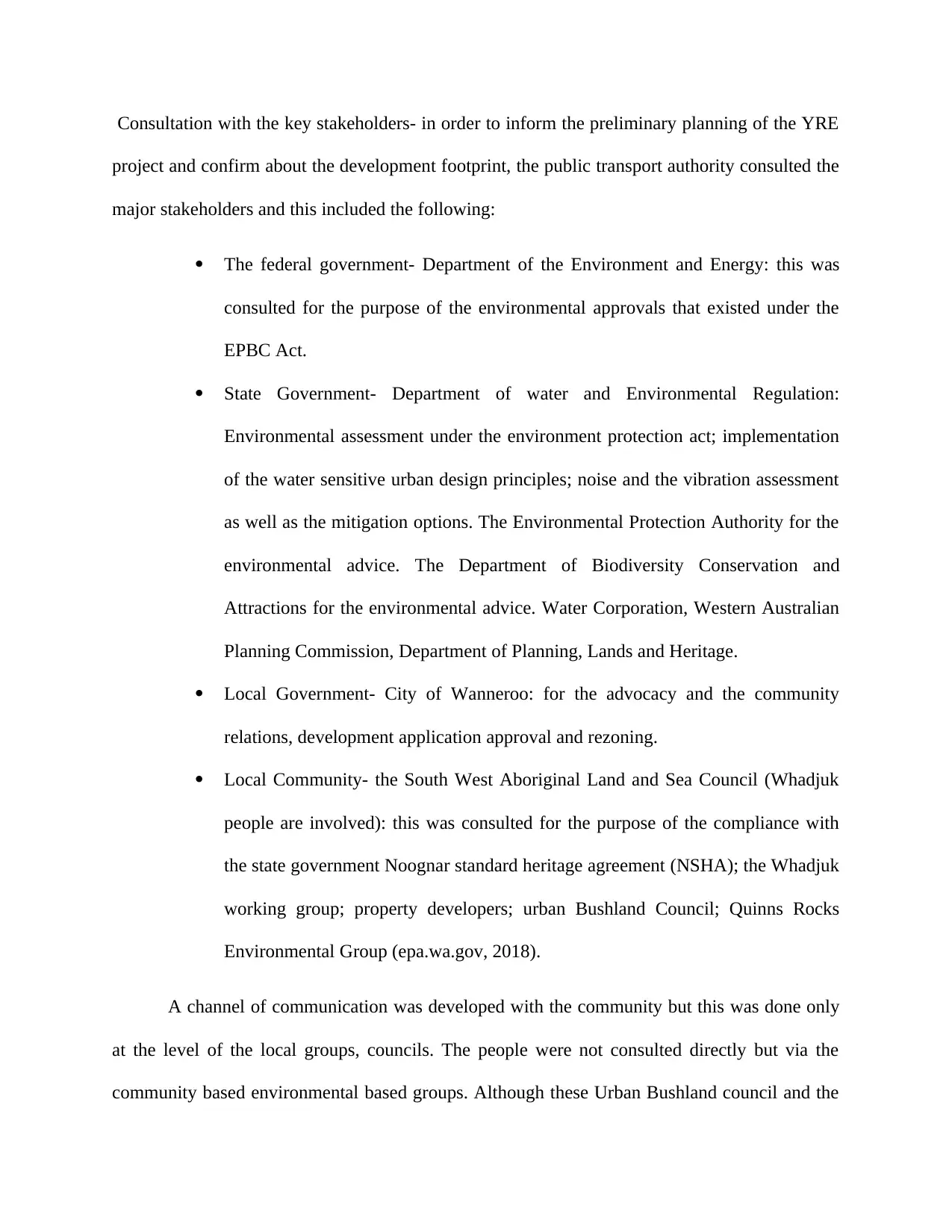
Consultation with the key stakeholders- in order to inform the preliminary planning of the YRE
project and confirm about the development footprint, the public transport authority consulted the
major stakeholders and this included the following:
The federal government- Department of the Environment and Energy: this was
consulted for the purpose of the environmental approvals that existed under the
EPBC Act.
State Government- Department of water and Environmental Regulation:
Environmental assessment under the environment protection act; implementation
of the water sensitive urban design principles; noise and the vibration assessment
as well as the mitigation options. The Environmental Protection Authority for the
environmental advice. The Department of Biodiversity Conservation and
Attractions for the environmental advice. Water Corporation, Western Australian
Planning Commission, Department of Planning, Lands and Heritage.
Local Government- City of Wanneroo: for the advocacy and the community
relations, development application approval and rezoning.
Local Community- the South West Aboriginal Land and Sea Council (Whadjuk
people are involved): this was consulted for the purpose of the compliance with
the state government Noognar standard heritage agreement (NSHA); the Whadjuk
working group; property developers; urban Bushland Council; Quinns Rocks
Environmental Group (epa.wa.gov, 2018).
A channel of communication was developed with the community but this was done only
at the level of the local groups, councils. The people were not consulted directly but via the
community based environmental based groups. Although these Urban Bushland council and the
project and confirm about the development footprint, the public transport authority consulted the
major stakeholders and this included the following:
The federal government- Department of the Environment and Energy: this was
consulted for the purpose of the environmental approvals that existed under the
EPBC Act.
State Government- Department of water and Environmental Regulation:
Environmental assessment under the environment protection act; implementation
of the water sensitive urban design principles; noise and the vibration assessment
as well as the mitigation options. The Environmental Protection Authority for the
environmental advice. The Department of Biodiversity Conservation and
Attractions for the environmental advice. Water Corporation, Western Australian
Planning Commission, Department of Planning, Lands and Heritage.
Local Government- City of Wanneroo: for the advocacy and the community
relations, development application approval and rezoning.
Local Community- the South West Aboriginal Land and Sea Council (Whadjuk
people are involved): this was consulted for the purpose of the compliance with
the state government Noognar standard heritage agreement (NSHA); the Whadjuk
working group; property developers; urban Bushland Council; Quinns Rocks
Environmental Group (epa.wa.gov, 2018).
A channel of communication was developed with the community but this was done only
at the level of the local groups, councils. The people were not consulted directly but via the
community based environmental based groups. Although these Urban Bushland council and the
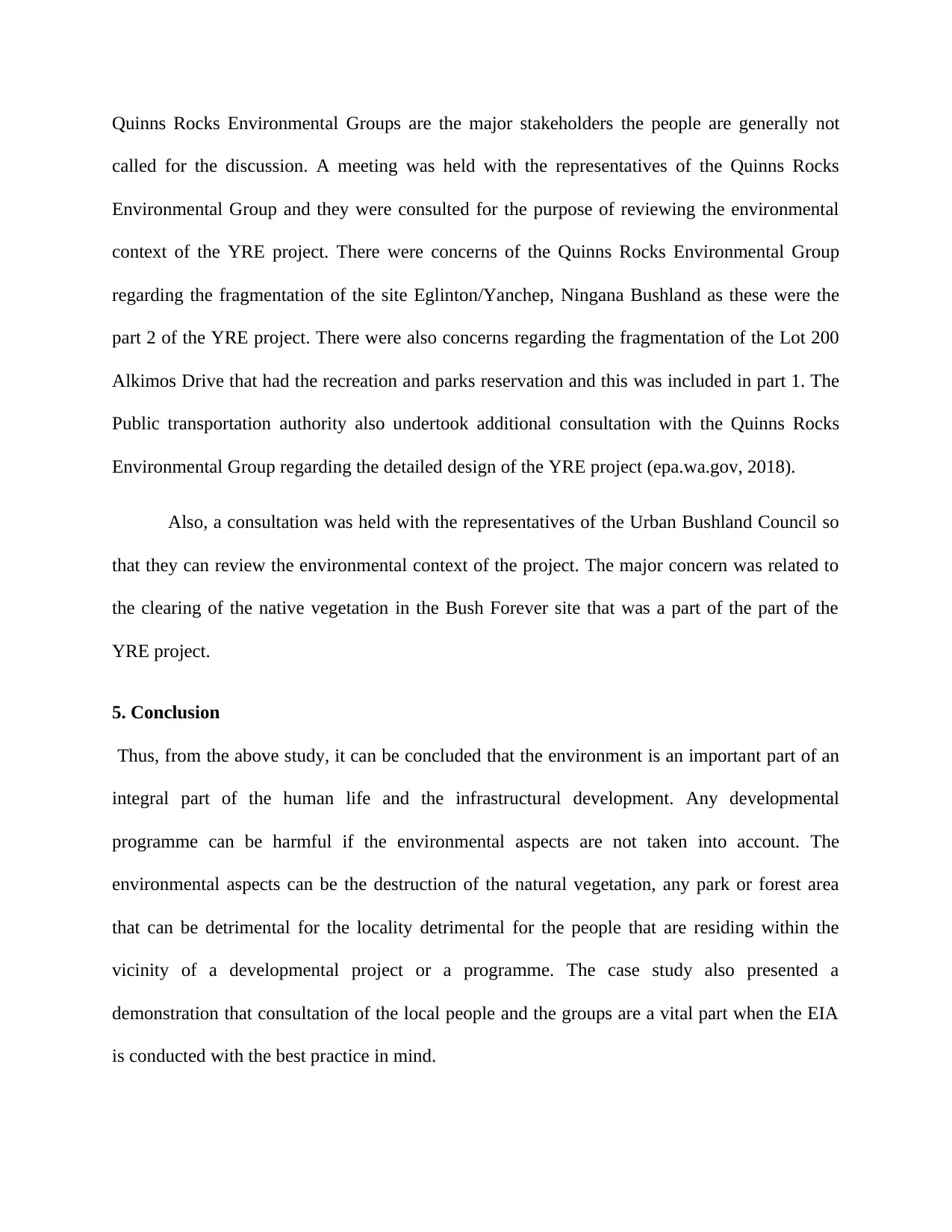
Quinns Rocks Environmental Groups are the major stakeholders the people are generally not
called for the discussion. A meeting was held with the representatives of the Quinns Rocks
Environmental Group and they were consulted for the purpose of reviewing the environmental
context of the YRE project. There were concerns of the Quinns Rocks Environmental Group
regarding the fragmentation of the site Eglinton/Yanchep, Ningana Bushland as these were the
part 2 of the YRE project. There were also concerns regarding the fragmentation of the Lot 200
Alkimos Drive that had the recreation and parks reservation and this was included in part 1. The
Public transportation authority also undertook additional consultation with the Quinns Rocks
Environmental Group regarding the detailed design of the YRE project (epa.wa.gov, 2018).
Also, a consultation was held with the representatives of the Urban Bushland Council so
that they can review the environmental context of the project. The major concern was related to
the clearing of the native vegetation in the Bush Forever site that was a part of the part of the
YRE project.
5. Conclusion
Thus, from the above study, it can be concluded that the environment is an important part of an
integral part of the human life and the infrastructural development. Any developmental
programme can be harmful if the environmental aspects are not taken into account. The
environmental aspects can be the destruction of the natural vegetation, any park or forest area
that can be detrimental for the locality detrimental for the people that are residing within the
vicinity of a developmental project or a programme. The case study also presented a
demonstration that consultation of the local people and the groups are a vital part when the EIA
is conducted with the best practice in mind.
called for the discussion. A meeting was held with the representatives of the Quinns Rocks
Environmental Group and they were consulted for the purpose of reviewing the environmental
context of the YRE project. There were concerns of the Quinns Rocks Environmental Group
regarding the fragmentation of the site Eglinton/Yanchep, Ningana Bushland as these were the
part 2 of the YRE project. There were also concerns regarding the fragmentation of the Lot 200
Alkimos Drive that had the recreation and parks reservation and this was included in part 1. The
Public transportation authority also undertook additional consultation with the Quinns Rocks
Environmental Group regarding the detailed design of the YRE project (epa.wa.gov, 2018).
Also, a consultation was held with the representatives of the Urban Bushland Council so
that they can review the environmental context of the project. The major concern was related to
the clearing of the native vegetation in the Bush Forever site that was a part of the part of the
YRE project.
5. Conclusion
Thus, from the above study, it can be concluded that the environment is an important part of an
integral part of the human life and the infrastructural development. Any developmental
programme can be harmful if the environmental aspects are not taken into account. The
environmental aspects can be the destruction of the natural vegetation, any park or forest area
that can be detrimental for the locality detrimental for the people that are residing within the
vicinity of a developmental project or a programme. The case study also presented a
demonstration that consultation of the local people and the groups are a vital part when the EIA
is conducted with the best practice in mind.
⊘ This is a preview!⊘
Do you want full access?
Subscribe today to unlock all pages.

Trusted by 1+ million students worldwide
1 out of 15
Related Documents
Your All-in-One AI-Powered Toolkit for Academic Success.
+13062052269
info@desklib.com
Available 24*7 on WhatsApp / Email
![[object Object]](/_next/static/media/star-bottom.7253800d.svg)
Unlock your academic potential
Copyright © 2020–2025 A2Z Services. All Rights Reserved. Developed and managed by ZUCOL.





